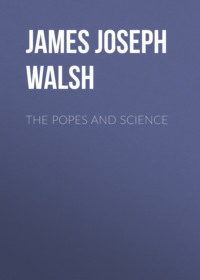 полная версия
полная версияПолная версия
Makers of Modern Medicine
It is one of the curious features of history that genuine worth of human accomplishment is almost in inverse ratio to the popularity it obtains in the generation in which it is produced. Supremely great work is rarely appreciated at anything like its proper value, by contemporaries. This principle is true apparently in all fields of human endeavor. In literature and in art it is a commonplace. But also, surprising though it may be, in science and in social betterment the rule holds a prominent place. It is nearly always the sign of only passing merit when any work secures the plaudits of its own generation. Brilliant theories are often immediately hailed with universal acclaim, while ground-breaking observations that are really great discoveries are apt to be neglected. The really new discovery is so novel that men cannot appreciate it at once. It is so different from their ordinary modes of thinking that they cannot place it properly. Its complete significance fails them.
This has been true for our nineteenth century biology almost more strikingly than for any other department of knowledge. Our many avenues of publicity instead of heralding abroad the great observations as soon as they have been made, in order to enable others to continue the work that the master mind has begun, have been only too constantly crowded with new opinions, novel theories, taking hypotheses, all attracting attention that they did not deserve. Men like Theodore Schwann, the father of the cell doctrine, are not apt to be so well known as the suggestor of some striking bit of theory. Even the great biologists, such as Darwin himself, are known rather for their insubstantial theories than for their substantial additions to biological knowledge by patient observation and genial penetration into the secrets of nature. It is perhaps a warning to the modern physician who realizes this state of affairs, not to take the popular theories even in his own branch of biology as the current coin of truth. Theories pass, but observations endure. Auenbrugger's new method of tapping the chest in order to elicit its varying sounds looked even more childish than Galvani's acceptance of the position of dancing master to a frog, but their observations thus made continued the germs of undying truth.
While the name and the life of Theodore Schwann are but little known by the general public, his work is very thoroughly appreciated by those who have made special studies in biology, and few men in the progress of that science are considered to hold as high a place as that assigned to him. A study of the life of Schwann will serve to show not only that he eminently deserves this honor which has come to him, but will also bring into evidence the fact that his career deserves to be better known popularly, because it illustrates very well the typical mode of life in which great scientists are nurtured and the methods of investigation by which great discoveries are made.
Of the men who have made the biology of the nineteenth century there are three whose names stand out with special prominence. They are noted not for their controversial writing on mooted points, but for ground-breaking, original work of the highest scientific import. Their discoveries will preserve their memories for posterity long after the names of many of those to whom the glare of controversial publicity lent an ephemeral brightness for their own generation shall have been forgotten. They are: Theodore Schwann, the anatomist, to whom modern biology owes its foundation by the establishment of the cell theory; Claude Bernard, the physiologist, to whom we are indebted for the great biological ideas of nervous inhibition and internal glandular secretion; finally Louis Pasteur, the chemist-bacteriologist, to whom is due the refutation of the annihilatory abiologic doctrine of spontaneous generation, and the discoveries that have revolutionized modern medicine and promise to accomplish as great a revolution in modern manufactures and industries.
It has often been said that the Catholic Church is opposed to scientific advance. It has especially been insisted that in what concerns biological science the Church's attitude has been distinctly discouraging. Recently the definite assertion has been made that no original thinker in science could continue in his profession of faith. Now, it so happens that all three of these men were born in the bosom of the Catholic Church, and were educated from their earliest years to maturity under her watchful care. Schwann and Pasteur remained in the midst of their great scientific triumphs her faithful sons. For years Bernard withdrew from all his old religious associations and became indifferent to the spiritual side of life, but before the end he came back to the knees of the Mother whose fostering care meant so much to him in early life.
Theodore Schwann, the first to formulate the cell doctrine, to promulgate the teaching that all living tissues, whether plant or animal, are composed of a number of minute elements which under all circumstances are biologically equivalent–is the father of modern biology. Cells had been seen and recognized as such before, but their significance was first pointed out by him. His cell theory has now become the cell doctrine, the teaching of all the schools of biology. The generalization that forms the basis of the doctrine was the result of some of the most accurate and careful observation that has ever been made. The work was done when the mechanical helps to the analysis of tissues were in the most primitive condition. The microscope had just been introduced into general laboratory work. The microtome, the instrument by which tissues are cut into thin sections suitable for microscopic examination, and to which almost more than to the microscope itself we owe our detailed knowledge of the intimate constitution of tissues, was as yet unthought of. Despite these drawbacks Schwann's work was done with a completeness that leaves very little to be desired. He published, when not yet thirty, the story of his comparative investigation of the cellular constitution of plants and animals, and there is very little that can be added, even in our day, to make its scientific demonstration any clearer than it was. It was typical of the man that, heedless of disputatious controversy over details of his work, he should go calmly on to complete it, and then give it to the world in all its convincing fulness. The same trait crops out with regard to other subjects. His was one of the great scientific minds of the century, always immersed in a philosophic calm befitting the important problems he had in hand. His life is ideal in its utter devotion to science, and to the teaching of science, while no duty that could round it out and make it humanly complete for himself or others was despised or neglected.
Theodore Schwann was the fourth of a family of thirteen children, born in the little German town of Reuss, not far from Cologne. He received his college education in the Jesuit Gymnasium of Cologne, and passed thence to the University of Bonn. The lower Rhineland is largely Catholic, and to this day, though Bonn has become the fashionable exclusive German university to which the Kaiser and many of the scions of the great German families go for their higher education, the faculty of theology at the university remains Catholic. Schwann devoted some time here to the study of theology, but he came under the influence of Johann Müller, was allowed to assist in some of his experiments on the functions of the spinal nerves of frogs, and this seems to have determined him to a medical career.
After two years spent in medicine at Würzburg, another great Catholic university of Southern Germany, we find Schwann at the University of Berlin, once more working with Johann Müller, who had been invited from Bonn to fill the distinguished Rudolphi's place in the chair of anatomy at the rising Prussian university. Müller was one of those wonderful men–they turn up, unfortunately, all too rarely–who, though not great discoverers themselves, have the invaluable faculty of inspiring students with an enthusiasm for original observation which leads to the most brilliantly successful researches. A great teacher, in the proper sense of the word, he was not. In his public lectures and his ordinary lessons he was often arid and uninteresting, insisting too much on unrelieved details, "the dry bones of science." He seems to have failed almost completely in conveying the usual scientific information of his course with the air of novelty that attracts the average student. The true teaching faculties are not given to many. Müller had a precious quality all his own that has proved much more valuable for science than the most enlightened pedagogy.
To the chosen few among his students who were drawn into close intimacy with him and permitted to share his personal scientific labors, Müller proved a source of most precious incentive–a suggestive master, the inspiration of whose investigating spirit was to be with them throughout life. To no one, except perhaps to Socrates of yore, has it been given to have sit at his feet as pupils so many men who were to leave their marks upon the developing thought of a great era in human progress. Beside Schwann, there studied with Müller, during these years at Berlin, Henle the anatomist, Brücke the physiologist, Virchow the pathologist, Helmholtz the physicist, Du Bois-Reymond the physiologist, Claparède, Reichert, Lachmann, Troschel, Lieberkühn and Remak. All these names are writ large in the scientific history of the century. It is a remarkable group of men, and of them Schwann, with the possible exception of Helmholtz, will be remembered the best by posterity; certainly none of them would not have cheerfully resigned his hopes of scientific renown for any work of his own to have made the discovery which, as an enthusiastic biographer said, set the crown of immortality on a young, unwrinkled forehead.
Schwann's thesis for his doctorate at Berlin showed the calibre of the man, and demonstrated his thorough fitness for success as an experimental scientist. The question whether the growing embryo in the ordinary hen's egg consumes oxygen or not had been in dispute for some time. It was well known that an air-chamber existed in the egg even at the earliest stages of embryonic life. It was understood that the mature chick just before its egress from the egg must have air, and the porosity of the egg-shell was sufficient to permit its entrance. Whether at the beginning of embryonic life within the egg, however, oxygen was necessary, remained somewhat in doubt. It had been demonstrated that the gas existing in the air-chamber of an egg became changed in composition during the progress of development. From being slightly richer in oxygen than ordinary atmospheric air at the beginning of embryonic growth, containing 24 to 25 parts of oxygen per 100, it became modified during comparatively early development so as to contain not more than 17 parts of oxygen per 100 and some 7 parts of carbon dioxide. This change of composition was, at least, very suggestive of the alteration that would take place during respiration. It was pointed out, however, that the argument founded on these observations was drawn only from analogy, and was by no means a scientific demonstration of the fact that the embryo not only consumed air during its growth, but actually needed oxygen for the continuance of its vital processes.
It was suggested that the change of composition in the air within the egg might be due not to any essential vital functions, but to chance alterations brought on by decomposition in the unstable organic material so abundantly present in the substance of the egg. Schwann settled the question definitely by a set of ingenious experiments. He exposed eggs for various periods to the action of other gases besides air, and also placed them in the vacuum chamber of an air-pump. When not in contact with the air the eggs developed for some hours if the temperature was favorable, and then development ceased. If after twenty-four hours' exposure to an atmosphere of hydrogen eggs were allowed free contact with the air, development began once more at the point at which it had ceased. After thirty hours of exposure to hydrogen, however, or to the vacuum, all life in the egg was destroyed, and it failed to develop no matter how favorable the conditions in which it was afterward placed. The completeness with which the points in dispute in this problem were demonstrated is typical of all Schwann's work. His conclusions always went farther than the solution of the problem he set out to solve, and were always supported by simple but effective experiments, often ingeniously planned, always carried out with a mechanical completeness that made them strikingly demonstrative.
One of Schwann's brothers had been a worker in metal, and Schwann himself had always shown a great interest in mechanical appliances. This hobby stood him in good stead in those days when laboratories did not contain all the intricate scientific apparatus and the facilities for experimentation so common now, with their workshop and skilled mechanics for the execution of designs. Many another worker in the biological sciences of that time owes his reputation to a similar mechanical skill. Experiments were impossible unless the investigator had the mechanical ingenuity to plan and the personal handiness to work out the details of appliances that might be necessary for experiments. It is told of Schwann that when Daguerre's discoveries in photography were announced, such was his interest in the new invention that he made a trip to Paris especially to learn the details of the method. Some daguerreotypes made by him according to the original directions of the inventor himself are still preserved by his family.
Schwann's investigation of the respiration of the embryo in hens' eggs led to further studies of the embryo itself, and to the discovery that it was made up of cells. Later came the resolution of other tissues into cells. When, after his graduation as doctor in medicine, the post of assistant in anatomy at Berlin fell vacant, it was offered by Johann Müller to Schwann. The position did not carry much emolument with it. The salary was ten German thalers–i.e., about $7.50 per month–a pittance even in those days when the purchasing power of money was ever so much greater than now. His duties took up most of his time. The work was congenial, however, and Schwann remained here for five years. As Henle has said in his biographical sketch of Schwann, in the Archiv f. mikroskopische Anatomie, just after his death in 1882: "Those were great days. The microscope had just been brought to such a state of perfection that it was available for accurate scientific observations. The mechanics of its manufacture had besides just been simplified to such a degree that its cost was not beyond the means of the enthusiastic student even of limited means. Any day a bit of animal tissue, shaved off with a scalpel or picked to pieces with a pair of needles or the finger-nails, might lead to important ground-breaking discoveries." For at that time almost everything as to the intimate composition of tissues was unknown. Discoveries were lying around loose, so to speak, waiting to be made. Schwann was not idle. The precious years at Berlin saw the discovery that many other tissues were composed of cells. The nuclei of the striped and unstriped muscles were found, and while the cellular character of these tissues was not demonstrated, their secret was more than suspected and hints provided for other workers that led very shortly to Kölliker's and Henle's discovery of muscle cells.
Besides his interest in histology, the branch of anatomy which treats of the intimate constitution of tissues, Schwann was working also at certain general biological questions, and at some knotty problems of physiology. Not long after his installation as an assistant at Berlin, from observations on fermenting and decomposing organic liquids, he came to a conclusion that was far in advance of the science of his day. He announced definitely infusoria non oriuntur generatione aequivoca--the infusoria do not originate by spontaneous generation. Under the term infusoria, at that time, were included all the minute organisms; so that Schwann's announcement was a definite rejection of the doctrine of spontaneous generation over thirty years before Pasteur's demonstrations finally settled the question. Schwann was never a controversialist. He took no part in the sometimes bitter discussions that took place on the subject, but having stated his views and the observations that had led up to them he did not ask for the immediate acceptance of his conclusions. He continued his work on other subjects, confident that truth would prevail in the end. When the congratulations poured in on Pasteur for having utterly subverted the doctrine of spontaneous generation, the great French scientist generously referred the pioneer work on this subject to Schwann, and sent felicitations to that effect when Schwann was celebrating the jubilee anniversary of his professoriate.
While studying ferments and fermentations Schwann became interested in certain functions of the human body that carry with them many reminders of the biological processes which are at work in producing the various alcohols and acids of fermentation. The changes that occur in the contents of the human stomach during the preparation of food for absorption had long been a subject of the greatest interest to physiologists. It had been studied too much, however, from the merely chemical side. The necessity for the presence of an acid in the stomach contents in order that digestion should go on led to the conclusion that the acid was the most important constituent of the gastric juice. By means of the scrapings of the stomachs of various animals Schwann succeeded in preparing an artificial gastric juice, and showed just how the action of the gastric secretions brought about the solution of the contents of the stomach. He isolated pepsin, and demonstrated that it resembled very closely in its action the substances known as ferments. He even hinted that digestion, instead of being a chemical was a biological process. Any such explanation as this was scouted by the chemists of the day, headed by Liebig. Most of the physiological functions within the human body were then triumphantly claimed as examples of the working of chemical laws.
Of the contradiction of his conclusions Schwann took practically no notice, but went faithfully on with his work. He could not be lured into controversy. For nearly five years he continued his work at the University of Berlin, receiving only the pittance that has been mentioned–less than ten dollars per month. Only the purest love of science for its own sake, and the satisfaction of his own enthusiastic spirit of investigation kept him at work. There was but little prospect of advancement at the University of Berlin itself. Schwann was one of the lowest in rank of the assistants; the professor was only just beyond the prime of life; and before Schwann on the list for promotion was at least one man, Henle, who had already done distinguished work. Germany had the good fortune to have all during the nineteenth century young men who, unmindful of present emolument, had been satisfied with the scantest wages for their support, provided the positions they occupied gave them opportunities for original work. Even at the present day young medical men are glad to accept what they consider the honor of the position of assistant to the professor and director of the clinic, and to remain in it for from five to ten years, sometimes even more, though the salary attached to it is only from $250 to $400 per year. They well know that if their original investigations into various medical questions are successful, advance in university rank is assured. Their promotion seldom comes from the institution where they have done their work, unless it should be one of the smaller universities; but the invitation to a chair at a university will come sooner or later for meritorious research.
Schwann's invitation came from Louvain. His work on cells had attracted a great deal of attention. In the midst of the rationalism and infidelity then so common among scientific men Schwann was known as a faithful, sincere Catholic. When the great Catholic University of Louvain, then, looked around for a professor of anatomy, he appeared to be the most suitable person. Henle, who had very little sympathy for Schwann's religious views, speaks most kindly of him as a man and a comrade. Schwann seems to have endeared himself to the "difficult" Prussians, as he did to those around him all his life. For the dominant note in the sketches of him by those who knew him personally is that of heartiest friendship, joined with enthusiastic admiration for his simple sincerity and unselfish devotion to his friends and to science.
A little incident that has been preserved for us by Henle shows how much his young contemporaries appreciated even at that early date, long before the full significance of the cell theory could be realized, the aspect of Schwann's work which was to make him immortal. At a little farewell dinner given him by his co-workers in various laboratories of the University of Berlin the feature of the occasion was a punning poem, by the toast-master, on the words Louvain and cells.
In German Louvain is Löwen, which also means lion; that is, it is the dative case of the name of the lion. Reference is made to the fact that as Samson found honeycomb (in German, bee-cells) in the lion, so now Louvain–i.e., in German, Löwen, the lion–finds a champion in the man of the cells. As Samson's riddle was suggested by finding the bee-cells, so will the new professor at Louvain solve the riddles of science by the demonstration of cells. The youthful jesting seer prophesied better than he knew. Schwann's first completed work at Louvain was the Microscopical Researches into the Accordance in Structure and Growth of Plants and Animals.11 The theory it advanced was to prove the most potent element thus far introduced into biological science to help in the solution of the difficult problems that constantly occur in the study of the various forms of life.
At Louvain, Schwann remained for about ten years. The period is marked by a continuance of his fruitful investigation of cell-life, of the physiological biology of ferments and fermentation, and of the allied subject of digestion in animals. His researches in Berlin on this interesting and important subject, which was practically a complete mystery at that time, had been mainly concerned with the gastric juice. He now began the study of various secretions which aid intestinal digestion. He proved that bile, which used to be considered an excretion, was really an important digestive secretion. He was not able to demonstrate the function of bile as completely as he had done for the gastric juice. The problem of intestinal digestion is much more complicated than that of stomach digestion, and involves a number of factors for which allowance has to be made if the value of any one of them is to be accurately determined. Even in our own day all of the physiological problems in the functions of biliary secretion are not solved. The greatest step was the demonstration that bile is a thing whose presence in the intestines is to be encouraged, not because, as Horace said, mental trouble was imminent unless one were purged of black bile in the springtime, but because its presence insures the proper preparation of food, and neutralizes in the intestinal tract certain poisonous substances that if absorbed would prove sources of irritation to all higher tissues.
His work on bile practically closes Schwann's career as an investigator. The seven years between twenty and twenty-seven were so full of discovery that there seemed to be great promise for his mature years. Had Schwann died at thirty his biographies would have surely contained lengthy comments on the great discoveries that would undoubtedly have rewarded his efforts in the prime of his powers. Schwann's seeming inactivity has been a fruitful cause for conjecture. The fact of the matter is, however, that original work of a high order is accomplished mainly during the time when activity of the imagination is at its height. There are very few cases in which this acme of inventive effort has lasted more than ten years.











